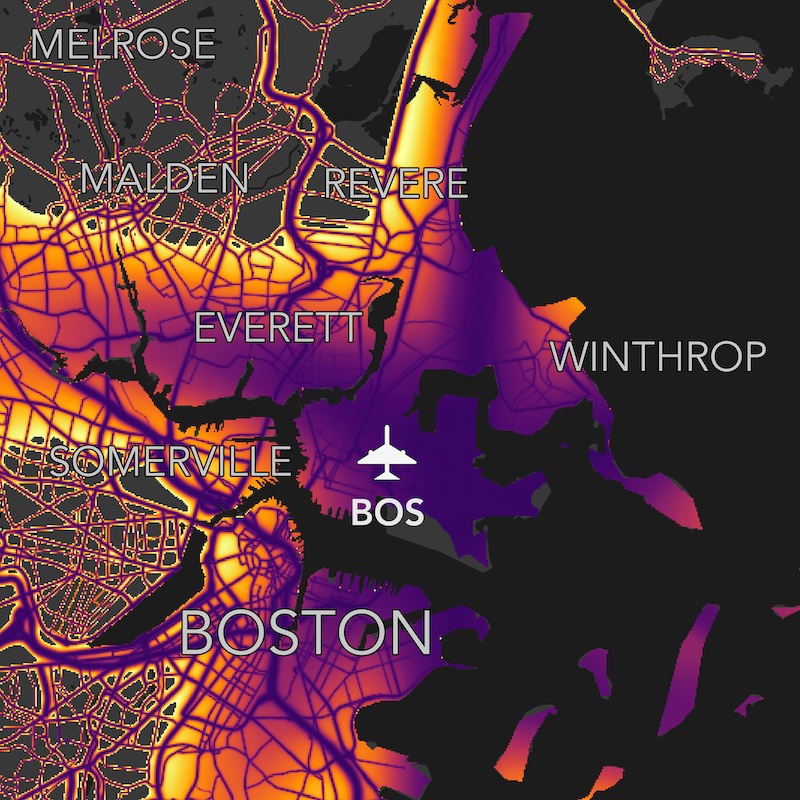Olmsted’s Parks

East Boston in 1906, prior to the airport
Though now dominated by the Boston Logan Airport, the landscape of East Boston was once comprised of marshes, coastlines, views of the harbor islands, and a few notable parks—including a park designed by Fredrick Law Olmsted, the “founder of landscape architecture.” In addition to the chain of Emerald Necklace parks, Olmsted designed his largest neighborhood park, Wood Island Park in East Boston. Located in one of Boston’s more isolated neighborhoods, Wood Island Park provided important recreational space for the growing working-class community, including a forested landscape, sports fields, and access to the water. The space was greatly appreciated by its residents, but during the expansion of Logan Airport, Wood Island Park was destroyed.

The Airport

1925 Photo of East Boston Airfield
In 1923, a military airfield opened in East Boston, and by 1929, was bought by the city and transitioned to passenger travel. Demand for air travel increased over the following decade, and in the 1940s, federal funds were earmarked for its expansion. The initial airport was built on landfill, away from the community of East Boston. During the 1950s, the airport was expanded into Boston Harbor using more landfill to build up shallow areas between Governors Island and Bird island . As Logan Airport added more runways and terminals, it encroached onto the existing neighborhoods. Continued expansions were met with resistance from the surrounding community of majority working-class Italian-Americans. Frustration grew significantly as further expansion cleared 70 acres of recreation space, including Wood Island Park in 1967. The airport was even likened to an octopus, sprawling across the community, taking up houses, parks and the like.1 Their complaints were seldom addressed, and promises to replace Wood Island Park’s recreational facilities were continuously deferred.
Too Much Noise
Loss of park space wasn’t the only concern for East Boston residents. As airplanes landed and took off within miles of their homes, the sounds and fumes of jet engines would inundate their communities. Community members sought to address issues of encroachment and pollution but complaints were often met with little response from Massport, the authority tasked with constructing the airport. Homes, and eventually streets, that were located too close to the airport were bought out. Following close behind Wood Island Park was the removal of Neptune Road and the surrounding streets. Other construction projects like the East Boston expressway brought even more noise to East Boston.

Excerpt from National Transportation noise map, areas in purple are over 70 decibels
In Boston today, noise pollution from the airport disproportionately affects East Boston, Chelsea, Winthrop and South Boston. Particulate pollution is also of concern among the residents, as well as the storage of jet fuel.
While Wood Island Park is no more, several parks now surround the airport to act as buffer zones between the airport and affected neighborhoods. East Boston Memorial Park and Bremen Street Community Park provide important space for recreation, including playgrounds, sports fields, walking paths, community gardens and a branch of the Boston Public Library. But noise from the airport, the highway, and the MBTA’s Blue Line linger over the beautiful green space.
The demographics of East Boston have shifted - it is now a predominately Latino community - but it continues to face many of the same challenges today. Organizations like GreenRootshave worked to address these Environmental Justice issues like access to clean air, water, and recreational space.
Learn more about East Boston and the work that GreenRoots engages in here.
-
From Dorothy Nelkin’s Jetport: The Boston Airport Controversy ↩︎
Our articles are always free
You’ll never hit a paywall or be asked to subscribe to read our free articles. No matter who you are, our articles are free to read—in class, at home, on the train, or wherever you like. In fact, you can even reuse them under a Creative Commons CC BY-ND 2.0 license.